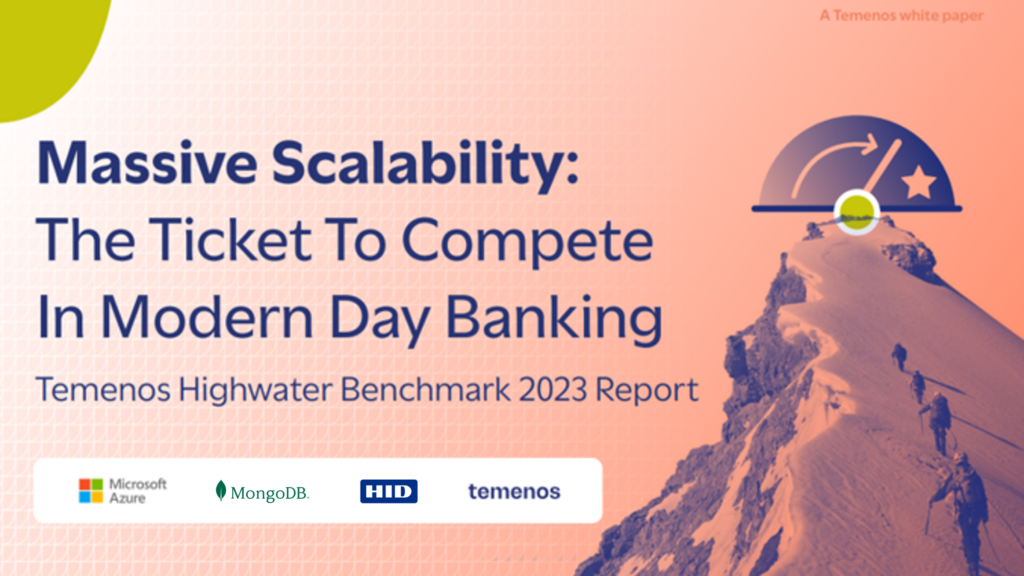
Flying Colors
Temenos’s Highwater Benchmark puts a fictitious bank through a series of simulations and tests. The results revealed that one single instance of a single platform can support multiple banking businesses, good news for Latin American banks with an eye on BaaS (banking as a service).
Big and grandiose plans are, quite literally, great. Turning them into money-making realties is even greater.
But with any real-life journey, there’re always bumps in the road and learning curves along the way.
Fortunately, that’s where experience can help both the newcomer and even a seasoned industry veteran
After 30 years in the banking software business, Temenos has that experience. Over those three decades, we’ve empowered financial institutions of all sizes to achieve their rapidly growing scalability goals. Today, they are thriving in their respective markets and industries. We remain committed to supporting both industry leaders of today and tomorrow, helping them scale and adjust course as needed to deliver best-in-class financial services.
For that reason, we’ve developed a simulation program called the Temenos Highwater Benchmark. In this laboratory, we team up with partners to evaluate the strength and resilience of the latest Temenos Banking Platform release, essentially by putting a fictitious entity through a rigorous and unique tech-intensive and financial-intensive stress test.

Here, we push the limits of what is possible in terms of elasticity, transaction performance, response times, efficiency and sustainability. The Temenos Highwater Benchmark results help our customers deliver innovative banking services with increased performance, sustainability and efficiency in the cloud.
Translation: how well can you scale in real life? How can you handle an unforeseen surge in demand for products and services? And most importantly, can your banking platform support you?
The answer to the last of these questions was an overwhelming yes. And then some.
For 2023, the program simulated a retail bank with 50 million customers (more than twice the population of Florida) and 100 million accounts. The bank sought to launch a Banking-as-a-Service (BaaS) proposition that would bring onboard 50 brands. Afterwards, it would add 50 million new customers to the process and generate 200 million embedded finance loans.

The entire scenario would take place on a single platform to determine if Temenos could handle the demand.
Benchmarking was conducted as an end-to-end, composed solution involving the core, payments, financial crime mitigation (FCM), Data Hub and digital channels on the Temenos Banking Cloud with the full core banking suite and Temenos Digital Banking. For the cloud capabilities, the test employed the Microsoft Azure platform and the MongoDB Atlas database. We also integrated HID, a third-party authenticator, to replace existing authenticating methods.
The result? The Temenos Banking Platform lived up to the performance and scalability requirements.
It successfully supported 100 million customers, 100 million accounts and 200 million embedded finance loans, thus achieving the project’s goal.
It handled 150,080 translations per second and 76 transactions per second per core.
The results revealed that one single instance of a single platform can support multiple banking businesses. Improvements vs a 2022 benchmark report included:
- 59% y-o-y average response time improvements
- <10 milliseconds – average query response time
- 210 milliseconds – instant payments response time
- 52% y-o-y like-for-like efficiency improvements
The result shows that banks on the Temenos Banking Platform can live up to the performance and scalability requirements of the near future as banks and non-banks are rapidly expanding in BaaS propositions.
And how do you explain issues involving linear scalability to the layman? Basically by saying this: when a financial entity requires more from its software, it must often add more hardware, sometimes disproportionately. This accumulation of inefficiencies can result in diminishing returns.
Why deal with that? Temenos’s solutions free up banks from worrying about such issues. We will do it for you so you can scale your business as demand requires. And we can make life easier for institutions of all sizes so they can focus on offering the best products and services for their customers.
As business evolves, a financial institution can rely on our platform and then scale with it. Don’t worry if you have lots of customers or products to offer, you can satisfy demand with complete and total confidence.
That’s good news for Latin American banks seeking to expand their BaaS capabilities to tap a growing need for embedded financial services.
The region’s BaaS market is estimated to grow at a compound annual growth rate of 20.2% from 2022 to 2027. 1
Separately, a recent Economist Impact survey of bankers worldwide conducted for Temenos posed the question: What are the top strategic priorities for your company in the next five years.
In Latin America, 30% said enabling embedded finance took top priority, more than any other region in the world in this category. In second place, North America trailed at 21%.
(For more information on the Economist Impact study, click here).
Demand for embedded finance produces demand for BaaS, which in turns boosts business for banks.
And it takes the right suite of digital banking offerings to succeed here, and we’ve subjected our products to tough tests to make sure they hold up when business booms.
Temenos can deliver that value so you can create value for your customers and shareholders.
Contact us today to learn more.

Temenos Highwater Benchmark
As banks are expected to seamlessly perform huge transaction volumes around the clock, the Temenos Banking Platform proves it’s massive scalability once again.